Clare Presland, Demon Barber, Eleanor Sanderson-Nash, Felicity Buckland, Gary Dixon, Harry Apps, Hugh Wheeler, humour, Jonathan Cooke, Jonathan Lyness, Matthew Sharp, relationships, Richard Studer, Robin Bailey, Sarah Bath, sex, Simon Wilding, Stephen Sondheim, violence, William Morgan
Sweeny Todd
Cutting Edge
Sweeny Todd “The Demon Barber of Fleet Street”
by Stephen Sondheim
West Green House Opera, at the Theatre on the Lake, Hartley Wintney, until 23rd July
Review by Mark Aspen
Picnics are a staple of the typical English country house opera, but seldom do you see the audience picnickers looking at their own meat pies with such circumspection before tucking in. You see, Sweeny Todd is not your usual opera. It is as gory a morsel as you could shake a meat cleaver at … and an opera where you can be sure that the majority of the cast will end up with sore throats.
West Green House Opera’s take on the well-known tale of “The Demon Barber of Fleet Street”, London’s tonsorial terror from the Victorian penny dreadfuls, , is a riotous rumbustious razor-fest, served up with wicked glee. Its gruesome Grand Guignol style in red and black makes a colourful feast for the eyes, and Sondheim’s urgent thrusting music a feast for the ears.
London born Hugh Wheeler, who wrote the book for Stephen Sondheim’s libretto and provided the authenticity of the Londoners’ speech, described Sweeny Todd as a “black operetta”. It may have the interludes of spoken dialogue of a musical, but the interwoven polyphony of the vocal score and the emotional complexity of the characters belong to opera.
Driving the on-stage West Green Opera Orchestra, conductor Jonathan Lyness, no stranger to the baton at West Green, absorbs himself totally in the performance. The impulsion of Sondheim’s score is delivered with gusto. He revels in Sondheim’s complex ostinato passages whilst capturing the lushness of lyrical contrasts. Here is an orchestra enjoying itself.
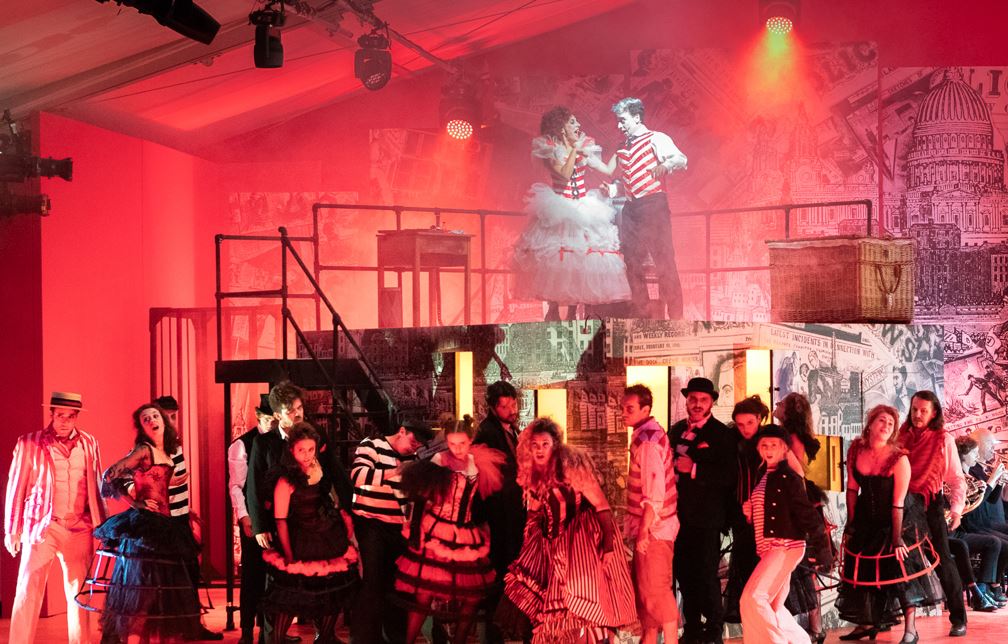
Also enjoying themselves are the busy ten-strong ensemble, who are never long offstage with their multiple roles as London crowds, costermongers or whores, stevedores, market shoppers, as well as the chorus. They are all well characterised, they play the minor roles … and some become victims of the Demon Barber.
Characters’ costumes have a subtle colour-coding, the barbers, Todd, Pirelli, the pseudo-Italian quack, and Tobias his assistant wear hooped red and white, the pattern of a barber’s pole; the seafarers and dockers, such as Anthony Hope the young lovelorn sailor, wear hooped blue and white, the Matelot pattern; those associated with the law, constables, the corrupt Beadle Bamford and the evil and dissolute Judge Turpin, the “baddies”, wear black and white. Jill Rolfe’s wardrobe has added a hint of punkery amongst all the Grand Guignolery. All this sits well in the overall red, black and white set. Director Richard Studer has compiled the design and the set is on two levels, Todd’s barber shop occupies the top floor with Mrs Lovett’s pie-shop below. The walls of this structure and of the backdrop are covered in blown-up montages of Victorian London newspapers with their ghastly news.
Sarah Bath pulls out all the stops (strops maybe?) to put a fine edge on her lighting designs, with dramatic use of saturated lighting plots. As you may imagine colour washes in blood red feature a lot. This is a melodrama after all.
There is too a large nod to Greek tragedy and the ensemble act in unison to comment on the action like a Greek chorus. One vehicle, energetically delivered, is The Ballad of Sweeney Todd, interpolated throughout; at first as the prologue and then as recurring commentary reprised seven times and developed with the plot.
The eponymous Sweeny Todd is full of vengeance. Transported to Australia on trumped up charges, he is back in London after fifteen years of hard labour in a penal colony. The prospect of being reunited with his beloved wife and daughter drives him, but he is seeking revenge on those who had corrupted the law and had sentenced him for their own loathsome gains. In melodrama though things escalate!
Black humour doesn’t get any darker than in Sweeny Todd. Yet while most of the characters garner the ghastly goings-on with undisguised glee, Sweeny himself is deadly serious, even in his humour. Matthew Sharp, playing the title role has this dichotomy nailed in his acting. There is a steely glint in his eye that is unnerving. Sharp, and what a great name for the razor-wielding barber, is multi-talented and, to his acting and directing skills, adds being an accomplished cellist. But here it is his striking baritone and his vocal acrobatics with the patter of the libretto that comes to the fore.
Yes, those razors. Mrs Nellie Lovett, proprietress of a (hitherto failing) meat pie shop, has been had a set of top-quality professional open razors in her safekeeping for fifteen years. It doesn’t take long for the sharp eyed and garrulous Mrs Lovett to recognise the returning Sweeney Todd as the wrongly convicted barber Benjamin Barker. Her news on the fate of Barker’s wife Lucy and daughter Johanna further inflames Todd and it is not long before they have a successful business partnership.
Clare Presland as Mrs Lovett is the perfect complement to Sharp’s Sweeny Todd. The versatile mezzo-soprano, who was recently Lucienne in the thematically not to dissimilar (but more serious), Die Tote Stadt, relishes the role of the pragmatically amoral pie-and-people dispenser. Presland is equally adroit with the acrobatic tongue-twisting libretto. Mrs Lovett is seductive in a black-widow spider way and has a sharp wit and quick mind.
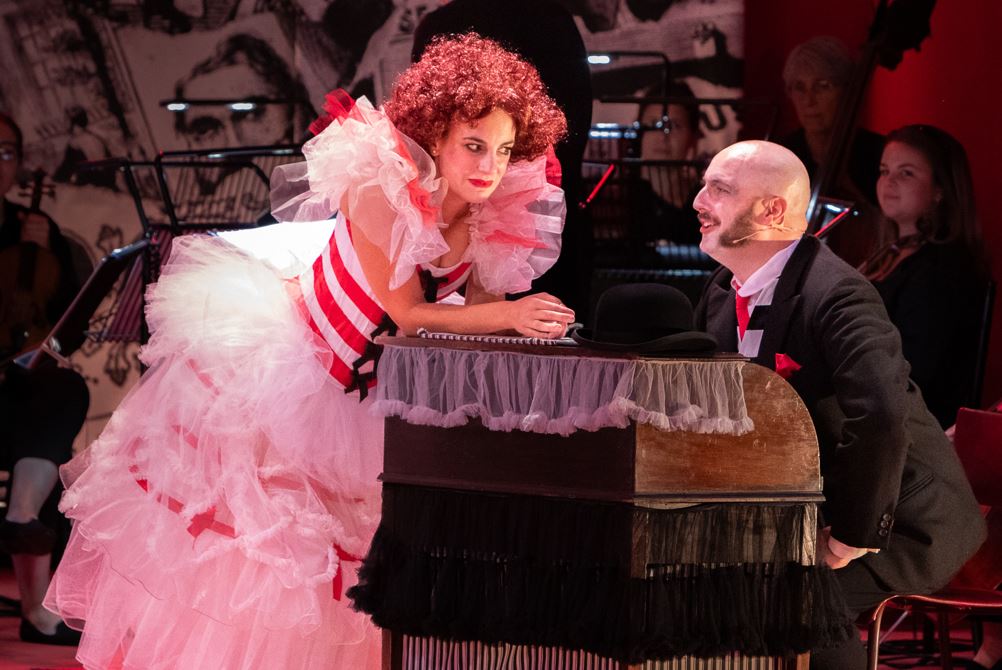
The Sweeny Todd – Mrs Lovett duet, A Little Priest makes a priceless culmination to the first half. It is outrageously funny, but not for the squeamish, as they discuss the merits as butcher’s meat of the different jobs and lifestyles of their hapless victims. The duet becomes more of a duel of words as they seek to outdo each other in rhyming the correlation of succulence against situation for each profession. Mrs L wins with “locksmith”. However, “it is clear that everyone goes down better with beer”.
Sondheim is a master in contrast, musically and in characterisation. A gutsy staccato passage, such as the Act Two opener God, That’s Good!, a tout ensemble piece with everyone tucking into the new pies, ignorant of their content, is followed by a gentle lyrical quartet, Johanna, opened by Anthony Hope.
Hope is young sailor who rescued Todd from the sea. The two returned to London on the same ship. Johanna becomes the musical motif for Anthony Hope after he meets and falls in love with a young woman of that name, who is held captive by her ward, Judge Turpin.
She is in fact Johanna Barker, the daughter of Sweeny Todd.
Tenor William Morgan (Prunier in West Green’s La Rondine) presents an Anthony Hope who is likable and with more than a modicum of charm. His lyrical tenor is ideal for the dreamy call Johanna. When he first meets his love, she is on a balcony, Juliet-like, and when they reach out their hands to each the tips of their fingers do not quite touch. It is an image that Michelangelo could have painted. (He did.) When Hope buys Johanna a caged bird as a love token, the symbolism is clear. Eleanor Sanderson-Nash’s beautiful and articulate soprano is shown to advantage in Johanna’s Green Finch and Linnet Bird. She is making her debut at West Green and is a voice to listen out for.
Beadle Bamford summarily strangles the bird. There is no room for prolonged sentimentality in the quick-flipping moods of this opera.
Beadle Bamford, the doer of dirty work for the evil Judge Turpin, might be a nasty piece of work, but he does get some great ditties. The sycophantic Beadle gingerly recommends Todd’s services to the Judge in the number Ladies in Their Sensitivities. A well-groomed chap has a better chance with the fair sex. Tenor Jonathan Cooke’s acting agility and versatile voice work well as Bamford, and when he later gets around the “ol’joanner” with Mrs Lovett, in Parlour Songs, the Beadle seems almost human. Beadle Bamford has come to enforce what would now be called the “environmental impact” of Mrs Lovett’s pie bakery. Whilst waiting for Todd to return with the key, he amuses himself with popular jingles. It could be said the environmental impact is quite high.
Simon Wilding is another versatile opera performer with a commanding stage presence. His rich bass voice imbues Judge Turpin with his (corrupted) authority as he strides around the stage in a long black cloak with white vents. There is something under the blackness, and in this opera every character, bar none, is three-dimensional. We spot weaknesses, and Turpin even undergoes a figurative self-flagellation in Johanna Mea Culpa to absolve his burgeoning lust for Johanna.
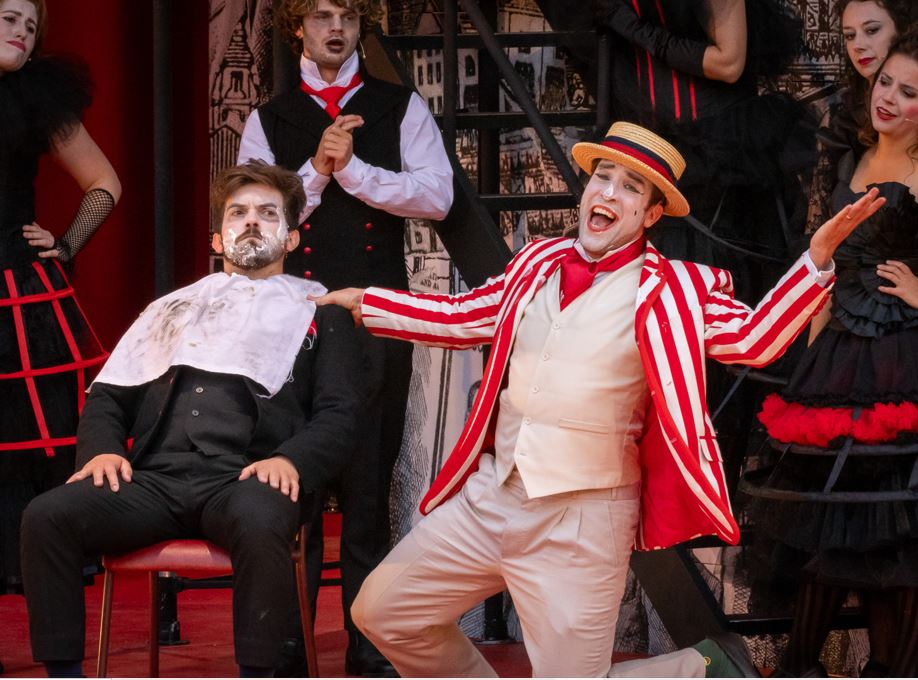
But there are other things going on. The arrival of Signor Adolf Pirelli towards the beginning of the paly introduces an, at first, figure of fun. With his boater and red and white striped blazer, and his Pantaloon face, he is a showman, presenting himself as a champion barber.
He speaks with an Italian accent of the add-a-an-a-to-a-everything-a-you-a-say-a variety. (Could Sondheim have written this today with the aversion to national stereotyping?)
Tenor Robin Bailey, who is one of the founder members of Voces8, has great fun in the role of Pirelli. There is great scope for slapstick humour, as well as nimble patter songs which Bailey tackles with vigour and a broad sense of humour, as Pirelli engages in shaving contests when challenged by Todd, and then on to a tooth pulling competition, both of which he loses, and concomitantly cements Todd reputation in the tonsorial arts.
Tobias Ragg, Pirelli’s hapless assistant, is the “patient” in the tooth pulling, but loss of his wig reveals the quackery behind Pirelli’s hair restorer. Young Ragg is one of the few empathetic characters in the opera (there aren’t many), although not the sharpest in his wits. Newcomer, Harry Apps puts a robust energy into the role. A picture remains of his leading a bargain-seeking crowd in Pirelli’s Miracle Elixir, taking a tumble on the wet stage and skilfully working in seamlessly into his routine.
Pirelli is in fact an Irish barber, one-time trained by Todd, and when he becomes Todd’s first victim when he threatens to blackmail Todd with his knowledge of Benjamin Buckley. Ragg is taken under the wing of Mrs Lovett and becomes her assistant, although intuitively he never trusts Todd. As time goes on Ragg becomes quite enamoured with Mrs Lovett, which Apps touchingly expresses in his tenor aria, Not While I’m Around. Mrs Lovett though has now built up a thriving business, since Todd has set up a production line with his new tilting chair and chute. Her romantic dreams are directed at Todd, and extend to retirement plans, By The Sea.
The most enigmatic character in Sweeny Todd is the Beggar Woman, and of all the ironies in the story, her fate is the most ironic. Symbolically she is an ubiquitous warning throughout the whole of the plot. Her life is an encyclopaedia of tragedy: her husband has been exiled; she has been drugged and raped by Judge Turpin; her daughter has been abducted; she is reduced to penury and prostitution; she roams the streets and the asylum, half-mad. Mezzo-soprano Felicity Buckland (who incidentally is married to Jonathan Cooke – and now a new mum) is superb in this exacting role. The Beggar Woman is Todd’s penultimate victim and the last to perish under one of his razors, his “friends”.
Sweeny Todd is a musical feast, a banquet of black humour and mountainous meal of macabre melodrama. With its wicked word-plays, labyrinthine song patterns, and physical comedy it is an enormously entertaining work. But it is more than that; it is an allegory. With a body-count slightly more than that of Hamlet, it asks what is achieved by revenge. Vendetta’s can only grow and in due course destroy the perpetrators. The irony in this story is that Todd ends up destroying himself and that that he loves. That penultimate victim is indeed, Lucy, his lost wife.
Mark Aspen, July 2023
Photography by Paul Reading
⭐⭐⭐⭐⭐
Rating: 5 out of 5.Leave a comment Cancel reply
This site uses Akismet to reduce spam. Learn how your comment data is processed.

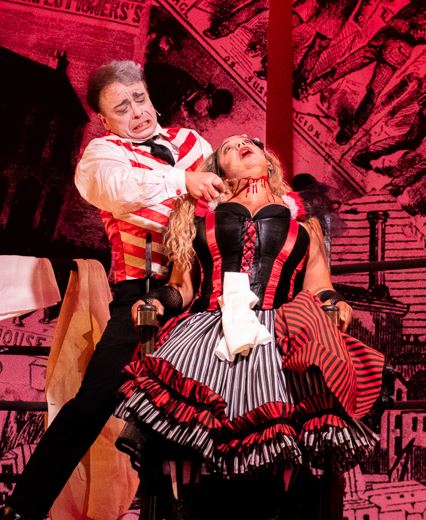
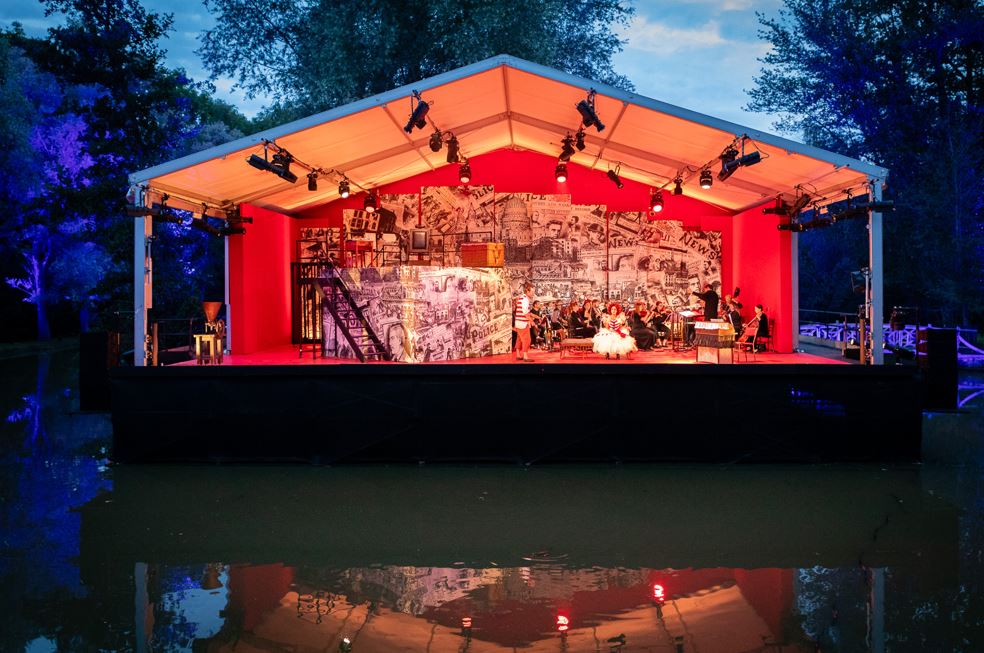
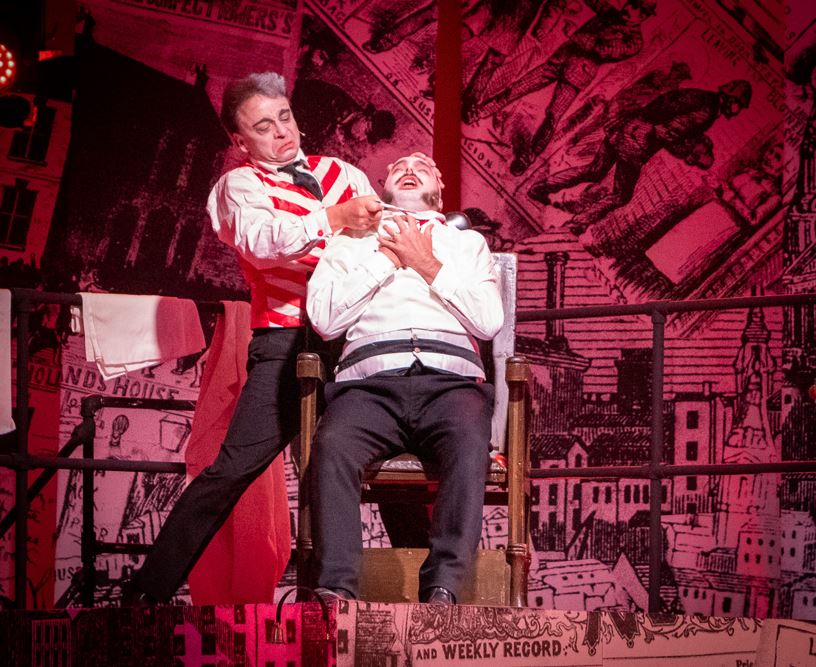
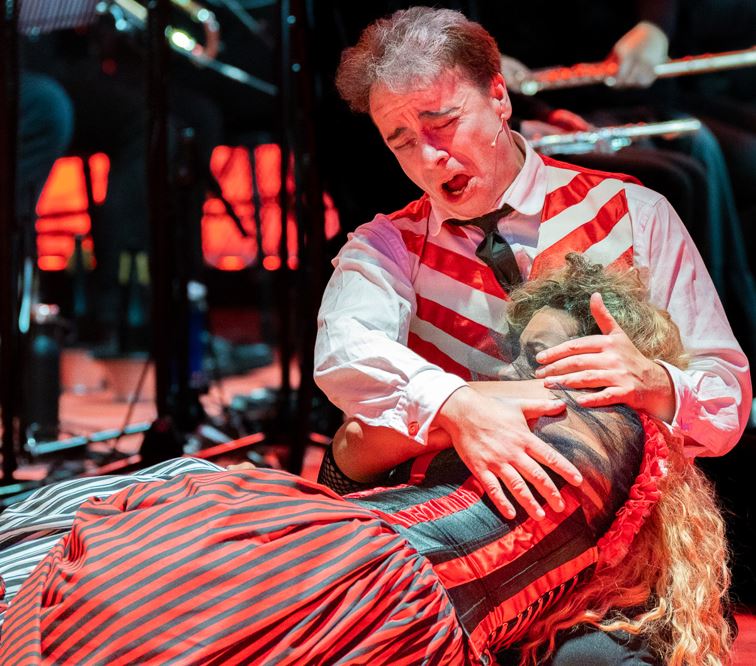
Trackbacks & Pingbacks